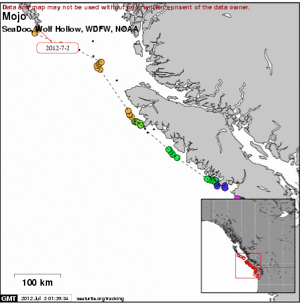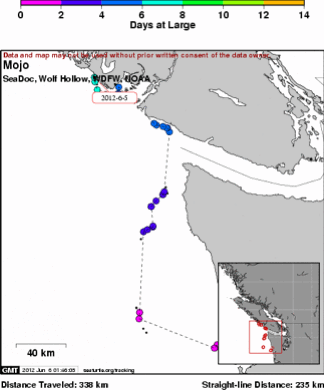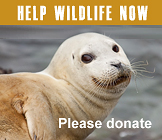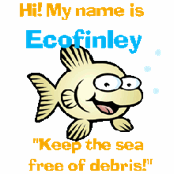mojo
Mojo the Steller sea lion pup makes it to Alaska rookeries
Jul/12/12 05:48 AM
Mojo, the Steller sea lion pup who was rescued on Washington’s outer coast, rehabbed at Wolf Hollow in the San Juans, and released back to the wild fitted with a satellite tracking device has made it all the way to the Alaska rookeries. A rookery is where sea lions (or seals) gather in large numbers to give birth, nurse their young and mate. Mojo has travelled 1484 km (over 922 miles) since his release on May 29th. Read all about Mojo here.
PUPDATE 7/23
Mojo continues to cruise northward along Alaska’s shoreline. As of yesterday, the satellite picked up his signal near Sitka. It looks like he is thriving in the wild. Soon, however, we will lose contact with him as he molts his fur and the glued-on tag falls off.
PUPDATE 7/23
Mojo continues to cruise northward along Alaska’s shoreline. As of yesterday, the satellite picked up his signal near Sitka. It looks like he is thriving in the wild. Soon, however, we will lose contact with him as he molts his fur and the glued-on tag falls off.
Mojo on the move again - sighted in Canada
Jul/01/12 06:37 AM
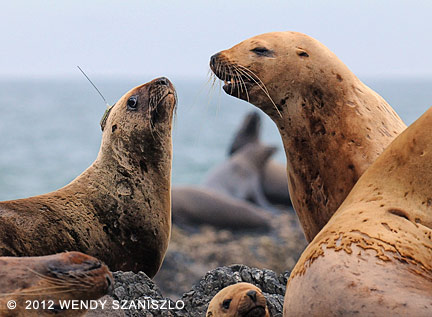
A marine mammal biologist (who also volunteers with the British Columbia Marine Mammal Stranding Response Network) was doing routine re-sights of branded animals when she noticed Mojo with his satellite tag on a very busy and popular Steller haulout site, Long Beach Rocks. This is one of a number of haulouts in and adjacent to the Pacific Rim National Park. Long Beach is considered a year round haulout for Stellers. Biologist Wendy Szaniszlo conducted a 3-yr study of the seasonal abundance and distribution of sea lions in the park preserve. Stellers are considered a Species of Special Concern under Canada’s Species at Risk Act. Wendy reports that Mojo was observed in the “middle of the action”, which means he seems to have adapted well to life back in the wild.
You can follow Mojo’s travels on SeaDoc Society’s website and receive almost daily updates on his location. Since this photo was taken, he is on the move once again and headed further north, well beyond Vancouver Island into Queen Charlotte Sound. As you can see from the photo, this is the time of year when sea lions molt their fur. Soon, Mojo’s glued-on tag will fall off as he sheds his old coat and grows a brand new silky one and transmissions will cease. Many thanks to Wendy for sharing this photo! Read more about Mojo’s story here.
PUPDATE: 7/3/12
A satellite picked up a ping from Mojo’s transmitter yesterday and he has made it to Haida Gwaii (formerly known as the Queen Charlotte Islands), which consists of about 150 islands off the coast of British Columbia. More specifically, his location appears to be Gwaii Hanas National Park Reserve.
Mojo has travelled 962 km (over 598 miles) since released back to the wild on May 29th.
Mojo the sea lion an international traveler
Jun/07/12 08:26 AM
Mojo, the Steller sea lion pup released on the outer coast of Washington last week, quickly made his way north and has settled into Canadian waters. The most recent satellite hits place him near Tofino on Vancouver Island. The Tofino/Ucleulet area is known for large concentrations of Stellers, a threatened species. In only 7 days, he has travelled 310 km (192 miles). Mojo would have most likely been born in a Steller sea lion rookery located in Oregon or Alaska. Since he was at least 6 months old when rescued from Pacific Beach in Washington, it is conceivable that he spent time in Canada with his mom. Or perhaps he hooked up with another Steller in Washington who was headed north. We will never know why he chose to travel to Canada, but are relieved that he has found members of his own species to hang out with - and in a much safer territory than around the Columbia River at Oregon and Washington’s border, where up to 20 sea lions have been shot (see related story).
Follow Mojo’s travels on SeaDoc Society’s website.
Follow Mojo’s travels on SeaDoc Society’s website.
Mojo the Steller sea lion pup returned to the wild
Jun/01/12 08:22 AM
On February 16, 2012 WDFW Marine Mammal Investigations responded to a Steller sea lion pup at Pacific Beach. This is believed to be the same Steller pup that was reported numerous times in other locations over a two week period with sightings on the Long Beach Peninsula and in Ocean Shores. The pup was weak, dehydrated, emaciated, and appeared to be separated from his mother. The pup, named Mojo, was transferred the following morning to Wolf Hollow Rehabilitation Center for stabilization, treatment, and care. When he arrived at Wolf Hollow he weighed in at 80 lbs and within the first ten days he gained 11 lbs. After three and a half months of rehabilitation, Mojo weighed in at over 255 lbs., and was strong, healthy, and ready for release. He was to be fitted with a satellite transmitter that is glued to his pelt; this is a non-invasive procedure that does not harm the animal. When Mojo molts, the tag will fall off. However, we expect to receive data regarding his movements and foraging patterns for the next 3-5 months.
Mojo’s Release Day
At 4am on May 29, Seal Sitters’ lead investigator Robin Lindsey rendezvoused with WDFW-MMI biologist Dyanna Lambourn and her dedicated intern Erin D’Agnese for the trip up to Anacortes to catch the San Juan Island ferry. From the boat, as we approached Friday Harbor, we spied a pod of white-sided dolphins. Upon arrival at Wolf Hollow, the team discussed the game plan to sedate and transport Mojo on his long journey back home to the Washington coast, where he was rescued months before. Mojo, expecting his fish breakfast, instead was sedated, examined and fitted with flipper tags for identification purposes and a satellite tag.
The team eagerly carried the snoozing Mojo to the huge cage on the back of WDFW’s pickup. It was still a long day ahead for Mojo and WDFW who would transport him all the way out to the ocean. Within a few minutes, Mojo began to stir in the cage, sporting his fancy satellite hat. As the truck travelled along the highway, he looked curiously out at the moving landscape. We had many, many hours to go. Dyanna’s phone rang and it was a biologist from the outer coast, reporting a live sea otter who had been on the beach since late the day before. Numerous phone calls later, the logistics of getting the animal, suffering from seizures, to US Fish and Wildlife in Olympia were arranged. Dyanna would swing by on our way south to quickly assess and make a determination of the animal, most likely suffering from protozoal encephalitis. Another call came in about a dead harbor seal pup on the outer coast. We would pick the pup up for necropsy after releasing Mojo. The phone rang again - there was a harbor seal pup resting on the beach near our destination. This was just a glimpse into the demanding 24/7 daily life of this WDFW marine mammal biologist and the interns who not only juggle school and jobs, but devote countless hours volunteering for Fish and Wildlife.
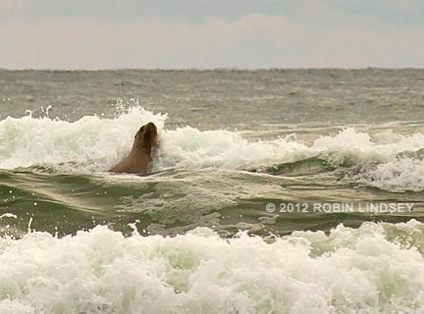
Following Mojo’s release, we scoured the beach south along the ocean for the seal pup reported earlier in the day. This is harbor seal pupping season along the outer coast, and pups use beaches that vehicles are allowed to drive upon. Last year, a pup was run over on the Fourth of July. We could not find the pup, but did find stakes and “Protected Marine Mammal” tape and headed to the highway. Arriving bleary-eyed back at our respective homes around midnight, it was an exhausting, but incredibly exhilarating day.
Mojo will provide invaluable data to the network. Sign up here for email updates showing a map of his travels. This case has been made possible, in large part, through the John H. Prescott Marine Mammal Rescue Assistance Grant Program. Tracking this animal would not be possible without the collaboration of several network groups which include: Washington Department of Fish and Wildlife Marine Mammal Investigations, Wolf Hollow Rehabilitation Center, SeaDoc Society, and NOAA's Protected Resources Division.
